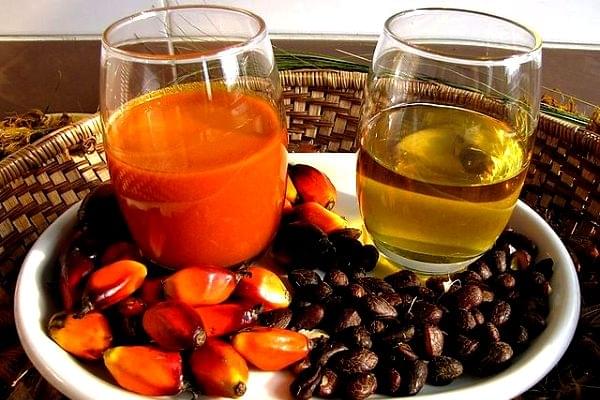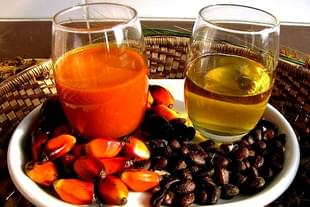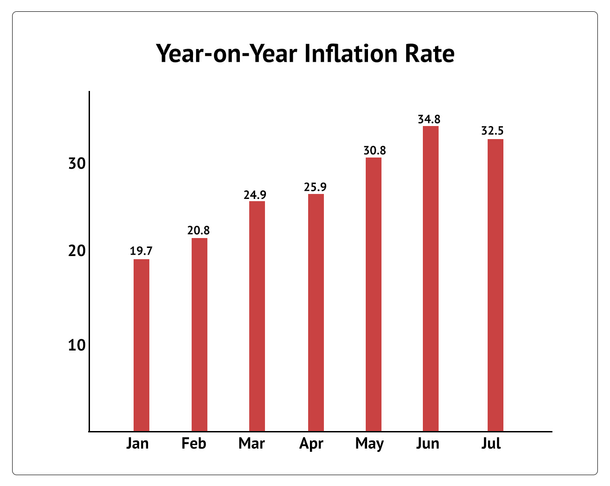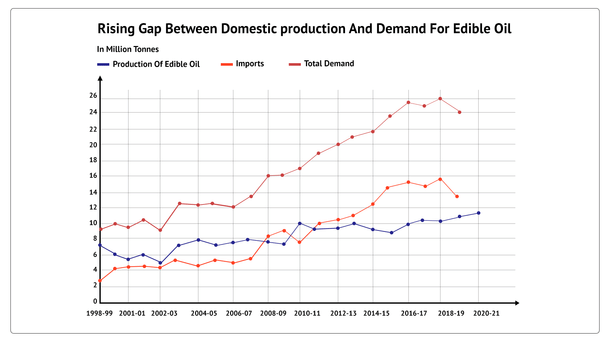Economy
Story Of Swinging Fortunes – Atmanirbharta In Edible Oil
Isha
Aug 18, 2021, 06:00 AM | Updated Aug 18, 2021, 12:40 AM IST
Save & read from anywhere!
Bookmark stories for easy access on any device or the Swarajya app.


India currently imports 55 per cent of its edible oil. While we have largely achieved self-sufficiency in foodgrain production, India is currently one of the largest importers of edible oil in the world. The 'Yellow Revolution' of the early 1990s could not achieve what the green or the white revolution did.
Earlier this year, we understood what this status meant for food security. Oil production in several oil-producing countries like Argentina and Malaysia suffered due to various reasons such as climate change and the pandemic. This had a huge inflationary impact on the prices of edible oil worldwide and in India. Among all food items, the consumer price index (CPI) for edible oil has been the highest all through the year, constantly in the double digits. India is heavily dependent on imports for one of the most basic commodities used in every household.

Becoming self-sufficient in the production of edible oil will not just help India attain food security but will also save the country thousands of crores that it spends on importing it.
Story of Swinging Fortunes
India was a net exporter of edible oil till 1965, after which we became a net importer. This again changed during the late 1980s and early 1990s where we once again achieved self-sufficiency and exported edible oil. But by the end of the century, India’s imports had started rising steadily.
One of the first-ever missions to achieve self-sufficiency in oil production was launched in 1986 called the Technology Mission on Oilseeds (TMO). Through TMO, appropriate technology was provided to farmers along with marketing and processing support. Subsequently, an integrated oilseeds policy was adopted in 1989 to support the farmers with technology inputs and remunerative prices for their produce. Through these interventions, we achieved self-sufficiency of 95 to 97 per cent during 1990-94.
Since then, the production of oilseeds dramatically fell. Some explanations offered for this are liberalisation of edible oil imports under Open General License (OGL) in 1994, stoppage of market intervention operation in April 1994, which stopped lines of credit offered to cooperative societies, increasing differences between MSPs of oilseeds and other foodgrains and change in production patterns of farmers. Since then, there has been no looking back; the share of imports kept rising.

Since the 90s, the consumption pattern too has undergone a shift. The demand for palm oil and soya oil has risen while demand for traditional oils such as groundnut and mustard have declined. For India, the top importers of soya oil are Argentina and Nepal in (2020-21), and the top importers of palm oil are Indonesia and Malaysia. Today, palm oil is the most popular edible oil.
Support for Palm Oil
Over the past few decades, there has been a meteoric rise in demand for palm oil. This can be observed from the rise in the proportion of palm oil in the import basket from 28 per cent of total oil imports in 1998-99 to 52 per cent in 2019-20. Further, Oil palm is the highest edible oil-yielding crop, capable of producing three to five tonnes of oil per hectare per annum in the country. Its productivity is higher than oilseeds such as sunflower, rapeseed (mustard), groundnut, soyabean, etc. India also has climatic conditions suited for the cultivation of palm oil.
One of the earliest support interventions for palm oil production was started in the eighth plan period called the Oil Palm Development Programme (OPDP). Under OPDP, 80,000 hectares were supposed to be brought under palm oil cultivation, mainly in Andhra Pradesh, Karnataka and Tamil Nadu.
By the end of the ninth plan period, 62,000 hectares were brought under palm oil cultivation. But by 2003-04, 20,000 hectares of palm oil plantations were uprooted as farmers were not receiving appropriate remunerative prices for their fresh fruit bunches (FFBs).
Later, the Integrated Scheme of Oilseeds, Pulses, Oil Palm and Maize (ISOPOM) was launched in 2003-04 and continued till 2013-14. Under ISOPOM, the area under oil palm cultivation grew gradually, and this scheme was subsequently restructured as National Mission on Oilseeds and Oil Palm (NMOOP) since 2014 which has been subsumed into the National Food Security Mission (Oilseeds and Oilpalm) (NFSM-OS&OP). The new mission also gave emphasis to the North Eastern states of India, where cultivation could be practised.
But although the potential area of cultivation in India is estimated to be 19.33 lakh hectares, the actual coverage is 3.49 lakh hectares up to October, 2019. Several problems ail this industry which includes long gestation periods, smallholding of farmers with limited resources, price instability due to fluctuation in international crude palm oil (CPO) prices and competition with crops like Tea, Rubber and Areca nut.
The Prime Minister, while transferring the ninth instalment of cash through the PM-KISAN scheme, announced the new National Edible Oil Mission-Oil Palm (NMEO-OP) with an outlay of Rs 11,000 crore.
This announcement comes in the backdrop of the steep rise in prices of edible oils earlier this year. Some of the reasons being pandemic induced labour supply disruptions in Malaysia, climate change issues in Brazil and Argentina and unusually high demand of soya oil in China. This situation forced the government to take active measures to expand the area under cultivation of oilseeds in Kharif sowing season by announcing a mini strategy in May where the ministry distributed high yield varieties of oilseeds. It aims to bring an additional 6.37 lakh hectares of land under the cultivation of oilseeds.
Reasons why NMEO-OP is need of the hour
Edible oil is a basic commodity used by every household in the country. A rise in prices will hurt the economically weaker sections the most. If production becomes self-sufficient, the government will have much more say in its prices and can use market interventions if necessary. This would also save thousands of crores of rupees through import substitution.
India cannot be held hostage to the vagaries of socio-economic conditions of exporting countries for access to such a basic commodity. Moreover, with the issue of climate change gaining traction, certain exporting countries are looking to produce alternative sources of energy through vegetable oil instead of exporting it.
Lastly, the demand for edible oil is only poised to increase in the coming years. The per capita consumption of edible oil has been steadily rising over the years from 14.3 kg in 2009-10 to 19.8 kg in 2019-20. With demand set to rise and projected supply looking unsteady, it is time to reclaim the common ingredient to all our favourite snacks.





